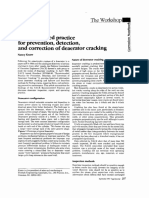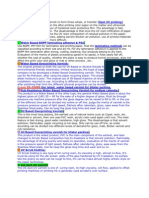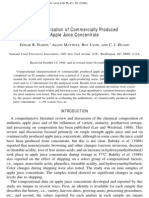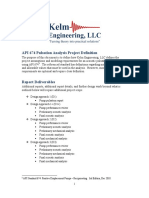Pigment Dispersion-EN
Pigment Dispersion-EN
Uploaded by
FA AyCopyright:
Available Formats
Pigment Dispersion-EN
Pigment Dispersion-EN
Uploaded by
FA AyCopyright
Available Formats
Share this document
Did you find this document useful?
Is this content inappropriate?
Copyright:
Available Formats
Pigment Dispersion-EN
Pigment Dispersion-EN
Uploaded by
FA AyCopyright:
Available Formats
Lankem
Expertise in surfactant technology
Dispersing Agents
w w w. l a n k e m . e u
Company Background
Lankem are a global supplier of speciality surfactants with expertise in all market sectors. Our strength lies in our technical backup to ensure that the customer gets the correct surfactant recommendation for each particular application. Each and every surfactant behaves in a unique way depending on whether you require high foam, low foam, good wetting, good detergency, particular surfactant properties or in the case of this guide a surfactant that offers good dispersing properties. If you need to contact our technical department the email is technical@ lankem.co.uk Also for a full list of all commercially available products then please click Product Range. If you require specific products that are not listed in the guide then please contact our technical department with your specific product requirements.
Lankem are also able to offer a customer specific service of providing
customer own label products, either as a re-brand or blend.
Pigment Dispersion Process
The process of producing pigment dispersions involves grinding the solid pigment agglomerates into primary particles and then stably and homogeneously distributing these throughout the liquid binder. If these stages are inefficient flocculation may occur causing colour change, sedimentation, gloss and changes in viscosity. Step 1. Starting pigment agglomerates are tightly packed particles separated by air and moisture. This moisture and air is then replaced by the liquid binder in the wetting stage. To improve this stage wetting agents can be used. Step 2. The pigment agglomerates are the separated by techniques such as grinding, ball milling, small media milling and high-speed dispersing. This process also reduces the size of the pigment particles into primary particles and disperses the pigments throughout the liquid binder. Step 3. To prevent flocculation this dispersion must be stabilised by dispersants. Otherwise the pigment particles will attract to one another reforming the pigment agglomerate reducing colour strength and gloss.
technical@lankem.co.uk
Functionality of the Dispersing Agent
The dispersing agent acts as both a wetting agent and a dispersing agent. Wetting is necessary to improve the speed at which the liquid replaces the air on the pigment surface. Thereafter the product needs to be stable to its essential that the additive has good dispersing properties. The dispersing characteristics can be defined by two principles : electrostatic repulsion and / or steric hindrance between the pigment particles. This detailed as follows: Electrostatic repulsion The pigment particles adsorb anions (-) which then attracts a second layer of cations (+). This electrical double layer maintains the dispersion as the charged particles repel one another. This system requires a polar liquid binder such as water.
ELECTROSTATIC REPLUSION
Steric Hindrance The surfactant contains a pigment affinity group and a binder affinity group. The pigment affinity group adsorbs at the particle surface and the binder affinity group extends into the binder. If the protruding groups come into contact with one another cause a build up of osmotic pressure forcing the particles to separate.
HINDRANCE
Application Sectors :
Commercial @lankem.co.uk
Aqueous Organic Pigment Dispersing agents
Both Lansperse DS200W and Lansperse DS80 are the main dispersing agents used in this application sector. DS200W is non-ionic in nature while the DS80 is classed as an anionic surfactant. Both products have a bulk hydrophobe which helps to offer excellent steric hindrance. The DS80 also has some electrostatic repulsion due to its anionic charge. Both products can be used by the formulator either singularly or in combination. Synergistic effects are sometimes observed for anionic / non-ionic blends. Both product are the new generation of APE free with low VOC levels. Typical dosage levels will be between 1 - 5% on the pigment Lansperse DS200W Lansperse DS80 Datasheet Datasheet MSDS MSDS
Carbon Black Dispersing Agents
Due to the versatility of our Lansperse DS200W this product has found to be one of the best dispersing agents for carbon black available on the market. This product has excellent wetting and dispersing properties and due to its unique effect of lowering the viscosity of the system the formulator is able to increase the carbon black loadings within the formulation. Typical dosage levels will be between 1 - 5% on black Lansperse DS200W Datasheet MSDS
Dispersing agents for Pigment Masterbatches for Plastics
Pigment masterbatches are used in plastic formulations with the key requirement that the masterbatch is thermally stable at temperatures around 180C. Both Lansperse PPD01 and Lansperse P35A can be used as dispersing agents for pigmented systems where the end polymer may be extruded and moulded.
Lansperse PPD01 Lansperse P35A
Datasheet Datasheet
MSDS MSDS
Request a Sample
Request a Quote
E x p e r t i s e i n S u r f a c t a n t Te c h n o l o g y
Dispersing Agents for Solvents and UV
Traditional formulations based upon white spirit for example are being replaced with more modern liquid carriers that cannot contain water due to the nature of the end application. Some cartridge inks for example are low VOC and are using dispersing agents such as our Lansperse SUV to ensure good wetting and dispersing characteristics. The two main application areas for non-aqueous systems are Solvent Inks and UV Curable inks. The Lansperse SUV has found to be effective in these two industries because it needs to be hydrophobic in nature to be soluble while still providing good surfactant properties. Typical dosage levels will be between 1 - 5% on pigment Lansperse SUV Datasheet MSDS
Dispersing agents for Inorganic Pigment and Fillers
Lansperse SPA has been specifically developed to work as the primary dispersing agent for inorganic systems such as fillers. In particular inorganics such as Kaolin and calcium carbonate can be disperse in aqueous medium using our Lansperse SPA Typical dosage levels between 0.1 and 0.5% on weight of filler / pigment
Lansperse DIS145 is a very effective dispersing agent supplied in powder form. Its main use can be seen as a dispersant of inorganic pigments and fillers within an aqueous medium. In particular this product is very effective in dispersing carbon blacks, zinc oxide, sulfur, kaolin, talc and calcium carbonate. Typical dosage levels will be between 1 - 5% on weight of filler / pigment Lansperse SPA Lansperse DIS145 Datasheet Datasheet MSDS MSDS
Request a Sample
Request a Quote
Lankem Ltd - Charles Street - Dukinfield - Cheshire - SK16 4SD - United Kingdom Te l e p h o n e : 0 0 4 4 1 6 1 3 4 3 3 3 5 5 Fax 00 44 161 343 3366 Email : commercial@lankem.co.uk
W W W. L A N K E M . E U
You might also like
- Maxemul Alkyd Emulsifiers How ToDocument13 pagesMaxemul Alkyd Emulsifiers How ToFernando Stuar Campos Mendoza100% (1)
- BYK Rheology AdditivesDocument127 pagesBYK Rheology AdditivesAlbertNo ratings yet
- TEGODocument49 pagesTEGOMiguelAlegriaNo ratings yet
- Additives John Du BYKDocument78 pagesAdditives John Du BYKdougNo ratings yet
- Heat Seal Lacquers - How To Meet Today S and Tomorrow S Demands Od The Market 10.12.11. 04 PDFDocument17 pagesHeat Seal Lacquers - How To Meet Today S and Tomorrow S Demands Od The Market 10.12.11. 04 PDFamitNo ratings yet
- Recommended Practice For Prevention, Detection and Correction of Deaerator CrackingDocument2 pagesRecommended Practice For Prevention, Detection and Correction of Deaerator CrackingAnonymous gr5Pr9AV0% (1)
- DNA Extraction (Green Peas)Document4 pagesDNA Extraction (Green Peas)Bea Lim100% (2)
- Dow SurfactantsDocument12 pagesDow Surfactantsv100% (1)
- Li Edaplan Metolat Dispersing TechnologyDocument15 pagesLi Edaplan Metolat Dispersing TechnologyPulbere NeagraNo ratings yet
- How To Disperse and Stabili..Document12 pagesHow To Disperse and Stabili..tusharmechem100% (4)
- Dow Ink FormulationsDocument3 pagesDow Ink FormulationskarkamalusNo ratings yet
- Pigments For Printing InksDocument49 pagesPigments For Printing Inksplast_adesh75% (4)
- Elementis Selector Chart AdditiveDocument14 pagesElementis Selector Chart AdditiveEugene Pai100% (1)
- Easily Dispersible PigmentsDocument44 pagesEasily Dispersible PigmentsGwen WalkerNo ratings yet
- Printing Inks George R. Fuchs PresentationDocument13 pagesPrinting Inks George R. Fuchs Presentationmarwa anwerNo ratings yet
- Croda How To LoVOCoatDocument6 pagesCroda How To LoVOCoatkarla100% (1)
- BASF - PVP and More - 2009 - BrochureDocument20 pagesBASF - PVP and More - 2009 - Brochureb4rfNo ratings yet
- Dyes For Inkjets 3171eDocument7 pagesDyes For Inkjets 3171einsankamilNo ratings yet
- Huber's Alumina Trihydrate (ATH) A Versatile Pigment For Coatings, Inks, Adhesives, Caulks and Sealants ApplicationsDocument5 pagesHuber's Alumina Trihydrate (ATH) A Versatile Pigment For Coatings, Inks, Adhesives, Caulks and Sealants ApplicationsdewanibipinNo ratings yet
- Printing Ink FormulaDocument1 pagePrinting Ink FormulaAminulIslamNo ratings yet
- Water Based Gravure Printing InkDocument6 pagesWater Based Gravure Printing InkHiba Naser100% (1)
- WaxAdditives EN PDFDocument24 pagesWaxAdditives EN PDFAmm MarakataNo ratings yet
- Duroftal VPE 7186 Coil - e PDFDocument24 pagesDuroftal VPE 7186 Coil - e PDFPratik MehtaNo ratings yet
- Pigment Dispersion PDFDocument19 pagesPigment Dispersion PDFgalati12345No ratings yet
- UV Flexo Ink CompositionDocument9 pagesUV Flexo Ink CompositionMuhammad Halim0% (1)
- Polymerization of Acrylic MonomersDocument7 pagesPolymerization of Acrylic MonomersarsenalmctNo ratings yet
- Functions of Dispersing Additives in Ink: By: Adesh Katariya Manager-R&D, Tirupati Inks LTDDocument71 pagesFunctions of Dispersing Additives in Ink: By: Adesh Katariya Manager-R&D, Tirupati Inks LTDBoonyarit Lurdgrienggraiying100% (1)
- Printing Ink and Overprint VarnishDocument12 pagesPrinting Ink and Overprint VarnishHuong So luuNo ratings yet
- Byk Ts-A5 Putties enDocument6 pagesByk Ts-A5 Putties enSebastian GonzalezNo ratings yet
- Assessment of Pigment Dispersion (Progress in Organic Coatings)Document28 pagesAssessment of Pigment Dispersion (Progress in Organic Coatings)evoid50% (2)
- SpecialChem - Coalescing Agents in Coatings - Definition, Types & PropertiesDocument5 pagesSpecialChem - Coalescing Agents in Coatings - Definition, Types & Propertiesichsan hakim100% (1)
- Resinas para MetalDocument7 pagesResinas para MetalNissim Hazar CasanovaNo ratings yet
- Products For Unsaturated PolyestersDocument8 pagesProducts For Unsaturated PolyestersNgan100% (1)
- BYK B-G1 Wax ENDocument8 pagesBYK B-G1 Wax ENXuân Giang Nguyễn100% (1)
- How To Achieve Better Than Acrylic Performance Without Acrylics For Architectural and Masonry PaintsDocument45 pagesHow To Achieve Better Than Acrylic Performance Without Acrylics For Architectural and Masonry Paintssriatul2006No ratings yet
- Brochure FT Wax enDocument3 pagesBrochure FT Wax enkishanptlNo ratings yet
- Eastman Acid CatalyzedWood Coatings PDFDocument0 pagesEastman Acid CatalyzedWood Coatings PDFHugo WizenbergNo ratings yet
- Binders PDFDocument1 pageBinders PDFFriska Ayu LigoyNo ratings yet
- FP Pigments - Opacity Pigments, Cost Saving Opportunities in Architectural Coatings Paul DietzDocument22 pagesFP Pigments - Opacity Pigments, Cost Saving Opportunities in Architectural Coatings Paul DietzHiếu Mai Đức100% (1)
- Easaqua TolonateDocument11 pagesEasaqua TolonateAlptekinNo ratings yet
- Dispersing AgentsDocument6 pagesDispersing AgentsEdward MenezesNo ratings yet
- 09-40-002 LP Printing Inks - 4S GB - FinDocument4 pages09-40-002 LP Printing Inks - 4S GB - FinFiras_karboujNo ratings yet
- BASF industrial+Metal+CoatingsDocument12 pagesBASF industrial+Metal+CoatingsMaria Eugenia CiveiraNo ratings yet
- DSM Ind. Wood 2Document11 pagesDSM Ind. Wood 2RutherfordNo ratings yet
- Intro To Polyurethane PDFDocument26 pagesIntro To Polyurethane PDFhaidirNo ratings yet
- Clariant Wetting-AgentsDocument7 pagesClariant Wetting-AgentsAPEX SON100% (1)
- EDAPLAN METOLAT GF For Inorg Pigments 2017Document18 pagesEDAPLAN METOLAT GF For Inorg Pigments 2017manuel h.ddc.No ratings yet
- Tips Paint Amp Coating Industry June 2011Document100 pagesTips Paint Amp Coating Industry June 2011samilife1100% (3)
- Optical Brighteners CIBADocument16 pagesOptical Brighteners CIBAHHHOOOSSHSNo ratings yet
- Omnova Coatings PresentationDocument12 pagesOmnova Coatings PresentationNatalia Rodriguez100% (1)
- Waterborne Additives Brochure 2022 enDocument13 pagesWaterborne Additives Brochure 2022 enHelene Di marcantonioNo ratings yet
- Pigment Dispersion: Theodore G. VernardakisDocument19 pagesPigment Dispersion: Theodore G. VernardakisSyafri GtNo ratings yet
- OpvDocument11 pagesOpvPankaj KumarNo ratings yet
- ExtendersDocument33 pagesExtenderssbttbsNo ratings yet
- Jonwax Brouchere PDFDocument24 pagesJonwax Brouchere PDFShyam YadavNo ratings yet
- Product List: Additives and Resins For Liquid CoatingsDocument12 pagesProduct List: Additives and Resins For Liquid CoatingsAPEX SONNo ratings yet
- PerstorpDocument8 pagesPerstorpSundarNo ratings yet
- Dispersing Agents For Water-Based DTM CoatingsDocument36 pagesDispersing Agents For Water-Based DTM CoatingsRoman Isak100% (1)
- Industrial Inorganic PigmentsFrom EverandIndustrial Inorganic PigmentsGunter BuxbaumRating: 5 out of 5 stars5/5 (1)
- M Alkalinity and P AlkalinityDocument3 pagesM Alkalinity and P AlkalinityFA AyNo ratings yet
- Instrument QuestionsDocument71 pagesInstrument QuestionsFA AyNo ratings yet
- Boiler Feedwater DeaerationDocument5 pagesBoiler Feedwater DeaerationFA Ay100% (1)
- Weyer Group Engineering ConsultingDocument2 pagesWeyer Group Engineering ConsultingFA AyNo ratings yet
- SIM4ME ThermodynamicsDocument137 pagesSIM4ME ThermodynamicsFA AyNo ratings yet
- Classification of PolymersDocument14 pagesClassification of PolymersFA Ay67% (6)
- CHE10709 Air CompressorsDocument29 pagesCHE10709 Air CompressorsFA Ay100% (1)
- Polymerization Techniques Advantages and DisadvantagesDocument1 pagePolymerization Techniques Advantages and DisadvantagesFA Ay100% (7)
- Heat Exchanger PerformanceDocument31 pagesHeat Exchanger PerformanceFA AyNo ratings yet
- CHE10710 NitrogenDocument32 pagesCHE10710 NitrogenFA Ay100% (1)
- Liquid Process Piping: Part 5: ValvesDocument23 pagesLiquid Process Piping: Part 5: ValvesFA AyNo ratings yet
- CHE10209 Couplings Seals BearingsDocument36 pagesCHE10209 Couplings Seals BearingsFA AyNo ratings yet
- Engineering Encyclopedia: Saudi Aramco Desktop StandardsDocument12 pagesEngineering Encyclopedia: Saudi Aramco Desktop StandardsFA Ay100% (1)
- KLM Process Furnace Rev 3Document5 pagesKLM Process Furnace Rev 3FA AyNo ratings yet
- Centrifugal Pump AnalysisDocument69 pagesCentrifugal Pump AnalysisFA AyNo ratings yet
- Vedic Mathematics1Document191 pagesVedic Mathematics1FA AyNo ratings yet
- Torit Cyclone ManualDocument24 pagesTorit Cyclone ManualFA AyNo ratings yet
- Astral Attack and DefenseDocument21 pagesAstral Attack and DefenseFA AyNo ratings yet
- Flowcheck Guide To PumpsDocument3 pagesFlowcheck Guide To PumpsFA AyNo ratings yet
- Classification of PolymersDocument14 pagesClassification of PolymersFA Ay67% (6)
- Kinetics Technology International: Experienced Professionals Advanced ThinkingDocument5 pagesKinetics Technology International: Experienced Professionals Advanced ThinkingFA AyNo ratings yet
- Arts Fluid FlowDocument142 pagesArts Fluid Flowchem.tahirNo ratings yet
- 7 They Do Not Crumble Easily 7.2 Crystal GeometryDocument31 pages7 They Do Not Crumble Easily 7.2 Crystal GeometryAlbert Junior EvangelistaNo ratings yet
- Test Report of Lichen Bases Protein Powder PDFDocument6 pagesTest Report of Lichen Bases Protein Powder PDFAshwini DattaNo ratings yet
- SoW - Yr - 8 - Science 2011-2012Document28 pagesSoW - Yr - 8 - Science 2011-2012Leena PrasannaNo ratings yet
- 5 WW XUJCSXdi Az MMHNT I6Document3 pages5 WW XUJCSXdi Az MMHNT I6varshatagade126No ratings yet
- Mercially Produced Apple Juice ConcentrateDocument14 pagesMercially Produced Apple Juice ConcentrateL Guillermo RuedaNo ratings yet
- Unit 1 INTRODUCTION 1.1.introduction 1.2.objectives PDFDocument341 pagesUnit 1 INTRODUCTION 1.1.introduction 1.2.objectives PDFtoshugo100% (1)
- BT ConcreteDocument36 pagesBT Concreteglai RamosNo ratings yet
- Pontic SDocument52 pagesPontic SLalit Kumar100% (2)
- API 674 Report DeliverablesDocument3 pagesAPI 674 Report DeliverablesRahul JainNo ratings yet
- Spectrophotometers: Boeco Spectrophotometer Models S-200 Vis & S-220 Uv/VisDocument2 pagesSpectrophotometers: Boeco Spectrophotometer Models S-200 Vis & S-220 Uv/VisSher Jan AfridiNo ratings yet
- Transparent ElectronicsDocument22 pagesTransparent ElectronicsArunKumar100% (1)
- 42HW Chp13Document2 pages42HW Chp13Haffiz AtingNo ratings yet
- Solved Problems in Fluid MechanicsDocument19 pagesSolved Problems in Fluid MechanicsPrincess Janine CatralNo ratings yet
- Mass Transfer (Topic 2)Document23 pagesMass Transfer (Topic 2)Siswand BIn Mohd Ali0% (1)
- Asm HandbookDocument2 pagesAsm HandbookLilian RoseNo ratings yet
- Plastic Injection Mold CalculationsDocument10 pagesPlastic Injection Mold CalculationsfieraminaNo ratings yet
- SRD Project Doc FinalDocument65 pagesSRD Project Doc FinalRavi JoshiNo ratings yet
- Static Modulus of Elasticity and Possions Ratio ConcreteDocument7 pagesStatic Modulus of Elasticity and Possions Ratio ConcreteBunkun15No ratings yet
- SOAL LATIHAN-1 - Spring Loaded Safety ValveDocument3 pagesSOAL LATIHAN-1 - Spring Loaded Safety ValveRahmat AgungNo ratings yet
- Amplify Io 3701Document2 pagesAmplify Io 3701Julio GarcíaNo ratings yet
- BE Syllabus Civil Engineering 2008-2012 Anna UniversityDocument127 pagesBE Syllabus Civil Engineering 2008-2012 Anna UniversitydepakmunirajNo ratings yet
- Chemical Admixtures For ConcreteDocument10 pagesChemical Admixtures For ConcreteEligio Antonio CerdaNo ratings yet
- Oes & Its PrinciplesDocument5 pagesOes & Its Principlesmini p shendeNo ratings yet
- Boiler Phosphate TreatmentDocument4 pagesBoiler Phosphate TreatmentSilvina C. Gómez Correa0% (1)
- Eero Sjostrom Analytical Methods in Wood Chemistry, Pulping, and PapermakingDocument327 pagesEero Sjostrom Analytical Methods in Wood Chemistry, Pulping, and Papermakingnabila OktavianiNo ratings yet
- RT 12180Document2 pagesRT 12180daframseqNo ratings yet
- Zhen Hau Sing - Feasibility & Treatability StudyDocument59 pagesZhen Hau Sing - Feasibility & Treatability StudySean SingNo ratings yet













































































































